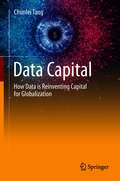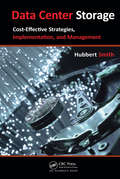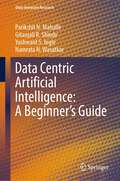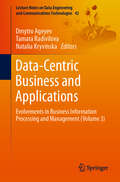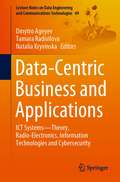- Table View
- List View
Data Breach Preparation and Response: Breaches are Certain, Impact is Not
by Kevvie FowlerData Breach Preparation and Response: Breaches are Certain, Impact is Not is the first book to provide 360 degree visibility and guidance on how to proactively prepare for and manage a data breach and limit impact. Data breaches are inevitable incidents that can disrupt business operations and carry severe reputational and financial impact, making them one of the largest risks facing organizations today. The effects of a breach can be felt across multiple departments within an organization, who will each play a role in effectively managing the breach. Kevvie Fowler has assembled a team of leading forensics, security, privacy, legal, public relations and cyber insurance experts to create the definitive breach management reference for the whole organization. Discusses the cyber criminals behind data breaches and the underground dark web forums they use to trade and sell stolen dataFeatures never-before published techniques to qualify and discount a suspected breach or to verify and precisely scope a confirmed breachHelps identify your sensitive data, and the commonly overlooked data sets that, if stolen, can result in a material breach Defines breach response plan requirements and describes how to develop a plan tailored for effectiveness within your organizationExplains strategies for proactively self-detecting a breach and simplifying a responseCovers critical first-responder steps and breach management practices, including containing a breach and getting the scope right, the first timeShows how to leverage threat intelligence to improve breach response and management effectivenessOffers guidance on how to manage internal and external breach communications, restore trust, and resume business operations after a breach, including the critical steps after the breach to reduce breach-related litigation and regulatory finesIllustrates how to define your cyber-defensible position to improve data protection and demonstrate proper due diligence practices
Data Capital: How Data is Reinventing Capital for Globalization
by Chunlei TangThis book defines and develops the concept of data capital. Using an interdisciplinary perspective, this book focuses on the key features of the data economy, systematically presenting the economic aspects of data science. The book (1) introduces an alternative interpretation on economists’ observation of which capital has changed radically since the twentieth century; (2) elaborates on the composition of data capital and it as a factor of production; (3) describes morphological changes in data capital that influence its accumulation and circulation; (4) explains the rise of data capital as an underappreciated cause of phenomena from data sovereign, economic inequality, to stagnating productivity; (5) discusses hopes and challenges for industrial circles, the government and academia when an intangible wealth brought by data (and information or knowledge as well); (6) proposes the development of criteria for measuring regulating data capital in the twenty-first century for regulatory purposes by looking at the prospects for data capital and possible impact on future society. Providing the first a thorough introduction to the theory of data as capital, this book will be useful for those studying economics, data science, and business, as well as those in the financial industry who own, control, or wish to work with data resources.
Data Center Handbook
by Hwaiyu GengProvides the fundamentals, technologies, and best practices in designing, constructing and managing mission critical, energy efficient data centers Organizations in need of high-speed connectivity and nonstop systems operations depend upon data centers for a range of deployment solutions. A data center is a facility used to house computer systems and associated components, such as telecommunications and storage systems. It generally includes multiple power sources, redundant data communications connections, environmental controls (e.g., air conditioning, fire suppression) and security devices. With contributions from an international list of experts, The Data Center Handbook instructs readers to: Prepare strategic plan that includes location plan, site selection, roadmap and capacity planning Design and build "green" data centers, with mission critical and energy-efficient infrastructure Apply best practices to reduce energy consumption and carbon emissions Apply IT technologies such as cloud and virtualization Manage data centers in order to sustain operations with minimum costs Prepare and practice disaster reovery and business continuity plan The book imparts essential knowledge needed to implement data center design and construction, apply IT technologies, and continually improve data center operations.
Data Center Handbook
by Hwaiyu GengProvides the fundamentals, technologies, and best practices in designing, constructing and managing mission critical, energy efficient data centers Organizations in need of high-speed connectivity and nonstop systems operations depend upon data centers for a range of deployment solutions. A data center is a facility used to house computer systems and associated components, such as telecommunications and storage systems. It generally includes multiple power sources, redundant data communications connections, environmental controls (e.g., air conditioning, fire suppression) and security devices. With contributions from an international list of experts, The Data Center Handbook instructs readers to: Prepare strategic plan that includes location plan, site selection, roadmap and capacity planning Design and build "green" data centers, with mission critical and energy-efficient infrastructure Apply best practices to reduce energy consumption and carbon emissions Apply IT technologies such as cloud and virtualization Manage data centers in order to sustain operations with minimum costs Prepare and practice disaster reovery and business continuity plan The book imparts essential knowledge needed to implement data center design and construction, apply IT technologies, and continually improve data center operations.
Data Center Handbook: Plan, Design, Build, and Operations of a Smart Data Center
by Hwaiyu GengDATA CENTER HANDBOOK Written by 59 experts and reviewed by a seasoned technical advisory board, the Data Center Handbook is a thoroughly revised, one-stop resource that clearly explains the fundamentals, advanced technologies, and best practices used in planning, designing, building and operating a mission-critical, energy-efficient, sustainable data center. This handbook, in its second edition, covers anatomy, ecosystem and taxonomy of data centers that enable the Internet of Things and artificial intelligent ecosystems and encompass the following:SECTION 1: DATA CENTER OVERVIEW AND STRATEGIC PLANNINGMegatrends, the IoT, artificial intelligence, 5G network, cloud and edge computingStrategic planning forces, location plan, and capacity planning Green design & construction guidelines and best practicesEnergy demand, conservation, and sustainability strategiesData center financial analysis & risk managementSECTION 2: DATA CENTER TECHNOLOGIESSoftware-defined environmentComputing, storage, network resource managementWireless sensor networks in data centersASHRAE data center guidelinesData center telecommunication cabling, BICSI and TIA 942Rack-level and server-level coolingCorrosion and contamination controlEnergy saving technologies and server designMicrogrid and data centersSECTION 3: DATA CENTER DESIGN & CONSTRUCTIONData center site selectionArchitecture design: rack floor plan and facility layoutMechanical design and cooling technologiesElectrical design and UPSFire protectionStructural designReliability engineeringComputational fluid dynamicsProject managementSECTION 4: DATA CENTER OPERATIONS TECHNOLOGIESBenchmarking metrics and assessmentData center infrastructure managementData center air managementDisaster recovery and business continuity managementThe Data Center Handbook: Plan, Design, Build, and Operations of a Smart Data Center belongs on the bookshelves of any professionals who work in, with, or around a data center.
Data Center Handbook: Plan, Design, Build, and Operations of a Smart Data Center
by Hwaiyu GengDATA CENTER HANDBOOK Written by 59 experts and reviewed by a seasoned technical advisory board, the Data Center Handbook is a thoroughly revised, one-stop resource that clearly explains the fundamentals, advanced technologies, and best practices used in planning, designing, building and operating a mission-critical, energy-efficient, sustainable data center. This handbook, in its second edition, covers anatomy, ecosystem and taxonomy of data centers that enable the Internet of Things and artificial intelligent ecosystems and encompass the following:SECTION 1: DATA CENTER OVERVIEW AND STRATEGIC PLANNINGMegatrends, the IoT, artificial intelligence, 5G network, cloud and edge computingStrategic planning forces, location plan, and capacity planning Green design & construction guidelines and best practicesEnergy demand, conservation, and sustainability strategiesData center financial analysis & risk managementSECTION 2: DATA CENTER TECHNOLOGIESSoftware-defined environmentComputing, storage, network resource managementWireless sensor networks in data centersASHRAE data center guidelinesData center telecommunication cabling, BICSI and TIA 942Rack-level and server-level coolingCorrosion and contamination controlEnergy saving technologies and server designMicrogrid and data centersSECTION 3: DATA CENTER DESIGN & CONSTRUCTIONData center site selectionArchitecture design: rack floor plan and facility layoutMechanical design and cooling technologiesElectrical design and UPSFire protectionStructural designReliability engineeringComputational fluid dynamicsProject managementSECTION 4: DATA CENTER OPERATIONS TECHNOLOGIESBenchmarking metrics and assessmentData center infrastructure managementData center air managementDisaster recovery and business continuity managementThe Data Center Handbook: Plan, Design, Build, and Operations of a Smart Data Center belongs on the bookshelves of any professionals who work in, with, or around a data center.
Data Center Networking: Network Topologies and Traffic Management in Large-Scale Data Centers
by Deke GuoThis book provides a comprehensive reference in large data center networking. It first summarizes the developing trend of DCNs, and reports four novel DCNs, including a switch-centric DCN, a modular DCN, a wireless DCN, and a hybrid DCN. Furthermore another important factor in DCN targets at managing and optimizing the network activity at the level of transfers to aggregate correlated data flows and thus directly to lower down the network traffic resulting from such data transfers. In particular, the book reports the in-network aggregation of incast transfer, shuffle transfer, uncertain incast transfer, and the cooperative scheduling of uncertain multicast transfer.
Data Center Networks: Topologies, Architectures and Fault-Tolerance Characteristics (SpringerBriefs in Computer Science)
by Yang Liu Jogesh K. Muppala Malathi Veeraraghavan Dong Lin Mounir HamdiThis SpringerBrief presents a survey of data center network designs and topologies and compares several properties in order to highlight their advantages and disadvantages. The brief also explores several routing protocols designed for these topologies and compares the basic algorithms to establish connections, the techniques used to gain better performance, and the mechanisms for fault-tolerance. Readers will be equipped to understand how current research on data center networks enables the design of future architectures that can improve performance and dependability of data centers. This concise brief is designed for researchers and practitioners working on data center networks, comparative topologies, fault tolerance routing, and data center management systems. The context provided and information on future directions will also prove valuable for students interested in these topics.
Data Center Storage: Cost-Effective Strategies, Implementation, and Management
by Hubbert SmithWe overspend on data center storage ... yet, we fall short of business requirements. It's not about the technologies. It's about the proper application of technologies to deliver storage services efficiently and affordably. It's about meeting business requirements dependent on data center storage. Spend less, deliver more. Data Center Storage: Cost-Effective Strategies, Implementation, and Management provides an industry insider's insight on how to properly scope, plan, evaluate, and implement storage technologies to maximize performance, capacity, reliability, and power savings. It provides business and use-case focused coverage of storage technology, including storage area networks (SAN), capacity-optimized drives, and solid-state drives. It offers key insights on financially responsible spending for data center storage. Delivered in accessible language, the book starts with a discussion of the business merits of replacing direct attached, compartmentalized storage with consolidated SAN-attached storage. The author advises on the use of service level applications (SLAs) as a tool to drive business unit collaboration with IT and prioritize those actions that impact productivity and profit from those that are less critical. This business guide to applied technologies disassembles big problems into digestible segments to help you understand, quantify, and fix any problems that arise as you work towards meeting your growing storage needs. The book builds on the consolidation and SLA driven approach to take advantage of the compelling benefits and potential savings of managed hosting and cloud storage.
Data Center Storage: Cost-Effective Strategies, Implementation, and Management
by Hubbert SmithWe overspend on data center storage ... yet, we fall short of business requirements. It's not about the technologies. It's about the proper application of technologies to deliver storage services efficiently and affordably. It's about meeting business requirements dependent on data center storage. Spend less, deliver more. Data Center Storage: Cost-Effective Strategies, Implementation, and Management provides an industry insider's insight on how to properly scope, plan, evaluate, and implement storage technologies to maximize performance, capacity, reliability, and power savings. It provides business and use-case focused coverage of storage technology, including storage area networks (SAN), capacity-optimized drives, and solid-state drives. It offers key insights on financially responsible spending for data center storage. Delivered in accessible language, the book starts with a discussion of the business merits of replacing direct attached, compartmentalized storage with consolidated SAN-attached storage. The author advises on the use of service level applications (SLAs) as a tool to drive business unit collaboration with IT and prioritize those actions that impact productivity and profit from those that are less critical. This business guide to applied technologies disassembles big problems into digestible segments to help you understand, quantify, and fix any problems that arise as you work towards meeting your growing storage needs. The book builds on the consolidation and SLA driven approach to take advantage of the compelling benefits and potential savings of managed hosting and cloud storage.
Data Center Virtualization Certification: Everything You Need To Achieve 2v0-622 Certification - With Exam Tips And Exercises
by Andrea MauroCertified VCP-DCV professionals must know to deploy and configure vSphere storage, networking, security and they should also be able to create and administer vSphere virtual machines. This comprehensive guide shows you how to optimize, secure, and troubleshoot all components of the implementation and helps you confidently approach the 2V0-622 exam.
Data Center Virtualization Certification: Everything you need to achieve 2V0-622 certification – with exam tips and exercises
by Andrea Mauro Paolo ValsecchiDeploy and configure vSphere infrastructure and learn to effectively create and administer vSphere virtual machines Key Features Implement advanced network virtualization techniques Configure and administer vSphere high availability Enhance your data center virtualization skills with practice questions and mock tests Book Description This exam guide enables you to install, configure, and manage the vSphere 6.5 infrastructure in all its components: vCenter Server, ESXi hosts, and virtual machines, while helping you to prepare for the industry standard certification. This data center book will assist you in automating administration tasks and enhancing your environment's capabilities. You will begin with an introduction to all aspects related to security, networking, and storage in vSphere 6.5. Next, you will learn about resource management and understand how to back up and restore the vSphere 6.5 infrastructure. As you advance, you will also cover troubleshooting, deployment, availability, and virtual machine management. This is followed by two mock tests that will test your knowledge and challenge your understanding of all the topics included in the exam. By the end of this book, you will not only have learned about virtualization and its techniques, but you'll also be prepared to pass the VCP6.5-DCV (2V0-622) exam. What you will learn Deploy and configure vSphere infrastructure Create and administer vSphere virtual machines Optimize, secure, and troubleshoot all vSphere components Implement vSphere HA on a vSAN cluster Understand how to back up and restore your vSphere 6.5 infrastructure Test your understanding of key concepts required through sample questions Who this book is for If you are interested in achieving Data Center Virtualization certification, this is the book is for you. You will also benefit from this book if you are a system administrator or network engineer. Some prior knowledge of virtualization can assist you in understanding key concepts covered in the book.
Data Center Virtualization Certification: Everything you need to achieve 2V0-622 certification – with exam tips and exercises
by Andrea Mauro Paolo ValsecchiDeploy and configure vSphere infrastructure and learn to effectively create and administer vSphere virtual machines Key Features Implement advanced network virtualization techniques Configure and administer vSphere high availability Enhance your data center virtualization skills with practice questions and mock tests Book Description This exam guide enables you to install, configure, and manage the vSphere 6.5 infrastructure in all its components: vCenter Server, ESXi hosts, and virtual machines, while helping you to prepare for the industry standard certification. This data center book will assist you in automating administration tasks and enhancing your environment's capabilities. You will begin with an introduction to all aspects related to security, networking, and storage in vSphere 6.5. Next, you will learn about resource management and understand how to back up and restore the vSphere 6.5 infrastructure. As you advance, you will also cover troubleshooting, deployment, availability, and virtual machine management. This is followed by two mock tests that will test your knowledge and challenge your understanding of all the topics included in the exam. By the end of this book, you will not only have learned about virtualization and its techniques, but you'll also be prepared to pass the VCP6.5-DCV (2V0-622) exam. What you will learn Deploy and configure vSphere infrastructure Create and administer vSphere virtual machines Optimize, secure, and troubleshoot all vSphere components Implement vSphere HA on a vSAN cluster Understand how to back up and restore your vSphere 6.5 infrastructure Test your understanding of key concepts required through sample questions Who this book is for If you are interested in achieving Data Center Virtualization certification, this is the book is for you. You will also benefit from this book if you are a system administrator or network engineer. Some prior knowledge of virtualization can assist you in understanding key concepts covered in the book.
Data-Centric Applications with Vaadin 8: Develop And Maintain High-quality Web Applications Using Vaadin
by Alejandro DuarteVaadin is an open-source Java framework used to build modern user interfaces. Vaadin 8 simplifies application development and improves user experience. The book starts with an overview of the architecture of Vaadin applications. You will also learn advanced concepts like,internationalization, authentication, authorization, and database connectivity
Data-Centric Applications with Vaadin 8: Develop And Maintain High-quality Web Applications Using Vaadin
by Alejandro DuarteVaadin is an open-source Java framework used to build modern user interfaces. Vaadin 8 simplifies application development and improves user experience. The book starts with an overview of the architecture of Vaadin applications. You will also learn advanced concepts like,internationalization, authentication, authorization, and database connectivity
A Data-Centric Approach to Breaking the FDI Trap Through Integration in Global Value Chains: A Case Study from Clothing Manufacturing Enterprises in Albania (Lecture Notes on Data Engineering and Communications Technologies #50)
by Jolta KacaniThis book reveals the hidden potential of emerging economies to become the new industrial hubs in existing global value chains. Pursuing a data-centric approach, it investigates the presence of foreign direct investment as an instrument for emerging economies to promote active participation in global value chains. This approach is based on time series analyses conducted at the national and industry level, and on datasets retrieved from international databases such as EORA, ICIO, and World Integrated Solutions. The outcomes of robust statistical models indicate that export-related innovations can improve trade openness and transform emerging economies into active players in global value chains. Researchers, developers, and professionals in the field will find a comprehensive and self-contained guide to the topic.
Data Centric Artificial Intelligence: A Beginner’s Guide (Data-Intensive Research)
by Parikshit N. Mahalle Gitanjali R. Shinde Yashwant S. Ingle Namrata N. WasatkarThis book discusses the best research roadmaps, strategies, and challenges in data-centric approach of artificial intelligence (AI) in various domains. It presents comparative studies of model-centric and data-centric AI. It also highlights different phases in data-centric approach and data-centric principles. The book presents prominent use cases of data-centric AI. It serves as a reference guide for researchers and practitioners in academia and industry.
Data-Centric Artificial Intelligence for Multidisciplinary Applications
by Parikshit N. Mahalle Gitanjali R. Shinde Namrata N. WasatkarThis book explores the need for a data‑centric AI approach and its application in the multidisciplinary domain, compared to a model‑centric approach. It examines the methodologies for data‑centric approaches, the use of data‑centric approaches in different domains, the need for edge AI and how it differs from cloud‑based AI. It discusses the new category of AI technology, "data‑centric AI" (DCAI), which focuses on comprehending, utilizing, and reaching conclusions from data. By adding machine learning and big data analytics tools, data‑centric AI modifies this by enabling it to learn from data rather than depending on algorithms. It can therefore make wiser choices and deliver more precise outcomes. Additionally, it has the potential to be significantly more scalable than conventional AI methods.• Includes a collection of case studies with experimentation results to adhere to the practical approaches• Examines challenges in dataset generation, synthetic datasets, analysis, and prediction algorithms in stochastic ways• Discusses methodologies to achieve accurate results by improving the quality of data• Comprises cases in healthcare and agriculture with implementation and impact of quality data in building AI applications
Data-Centric Artificial Intelligence for Multidisciplinary Applications
by Gitanjali R. Shinde Parikshit N Mahalle Namrata Nishant WasatkarThis book explores the need for a data‑centric AI approach and its application in the multidisciplinary domain, compared to a model‑centric approach. It examines the methodologies for data‑centric approaches, the use of data‑centric approaches in different domains, the need for edge AI and how it differs from cloud‑based AI. It discusses the new category of AI technology, "data‑centric AI" (DCAI), which focuses on comprehending, utilizing, and reaching conclusions from data. By adding machine learning and big data analytics tools, data‑centric AI modifies this by enabling it to learn from data rather than depending on algorithms. It can therefore make wiser choices and deliver more precise outcomes. Additionally, it has the potential to be significantly more scalable than conventional AI methods.• Includes a collection of case studies with experimentation results to adhere to the practical approaches• Examines challenges in dataset generation, synthetic datasets, analysis, and prediction algorithms in stochastic ways• Discusses methodologies to achieve accurate results by improving the quality of data• Comprises cases in healthcare and agriculture with implementation and impact of quality data in building AI applications
Data-Centric Business and Applications: Evolvements in Business Information Processing and Management (Volume 3) (Lecture Notes on Data Engineering and Communications Technologies #42)
by Dmytro Ageyev Tamara Radivilova Natalia KryvinskaBuilding on the authors’ previous work, this book addresses key processes and procedures used in information/data processing and management. Modern methods of business information processing, which draw on artificial intelligence, big data, and cloud-based storage and processing, are opening exciting new opportunities for doing business on the basis of information technologies. Thus, in this third book, the authors continue to explore various aspects – technological as well as business and social – of the information industries. Further, they analyze the challenges and opportunities entailed by these kinds of business.
Data-Centric Business and Applications: ICT Systems—Theory, Radio-Electronics, Information Technologies and Cybersecurity (Lecture Notes on Data Engineering and Communications Technologies #69)
by Dmytro Ageyev Tamara Radivilova Natalia KryvinskaThis book, building on the authors’ previous work, presents new communication and networking technologies, challenges and opportunities of information/data processing and transmission. It also discusses the development of more intelligent and efficient communication technologies, which are an essential part of current day-to-day life. Information and Communication Technologies (ICTs) have an enormous impact on businesses and our day-to-day lives over the past three decades and continue to do so. Modern methods of business information processing are opening exciting new opportunities for doing business on the basis of information technologies. The book contains research that spans a wide range of communication and networking technologies, including wireless sensor networks, optical and telecommunication networks, storage area networks, error-free transmission and signal processing.
Data-Centric Business and Applications: Advancements in Information and Knowledge Management, Volume 2 (Lecture Notes on Data Engineering and Communications Technologies #208)
by Solomiia Fedushko Peter Štarchoň Katarína GubíniováThis book stands out by exploring the significance of data in various aspects of business, including operations, decision-making, and application development, in a comprehensive and accessible manner. It delves into advanced topics such as data management, analytics, knowledge discovery, artificial intelligence, data-centric business models, emerging technologies, and ethical implications, providing a unique perspective. The book is appropriate for academics, professionals, and researchers with intermediate to advanced data management skills. Data plays a crucial role in today's rapidly evolving digital environment, serving as the foundation for businesses and the key element in driving innovation across diverse industries. This book delves into the latest advancements in data management, their impact on modern corporate settings, and advanced information and knowledge management concepts. The chapters in this book discuss various topics, including incorporating data-driven methods into business models, the difficulties and advantages of emerging technology, and the ethical aspects of making decisions based on data.
Data-Centric Business and Applications: Evolvements in Business Information Processing and Management—Volume 1 (Lecture Notes on Data Engineering and Communications Technologies #20)
by Natalia Kryvinska Michal GregušThis book discusses processes and procedures in information/data processing and management. The global market is becoming more and more complex with an increased availability of data and information, and as a result doing business with information is becoming more popular, with a significant impact on modern society immensely. This means that there is a growing need for a common understanding of how to create, access, use and manage business information. As such this book explores different aspects of data and information processing, including information generation, representation, structuring, organization, storage, retrieval, navigation, human factors in information systems, and the use of information. It also analyzes the challenges and opportunities of doing business with information, and presents various perspectives on business information managing.
Data-Centric Business and Applications: Evolvements in Business Information Processing and Management (Volume 2) (Lecture Notes on Data Engineering and Communications Technologies #30)
by Natalia Kryvinska Michal GregušThis book explores various aspects of data engineering and information processing. In this second volume, the authors assess the challenges and opportunities involved in doing business with information. Their contributions on business information processing and management reflect diverse viewpoints – not only technological, but also business and social. As the global marketplace grows more and more complex due to the increasing availability of data, the information business is steadily gaining popularity and has a huge impact on modern society. Thus, there is a growing need for consensus on how business information can be created, accessed, used and managed.
Data-Centric Business and Applications: Towards Software Development (Volume 4) (Lecture Notes on Data Engineering and Communications Technologies #40)
by Aneta Poniszewska-Marańda Natalia Kryvinska Stanisław Jarząbek Lech MadeyskiThis book explores various aspects of software creation and development as well as data and information processing. It covers relevant topics such as business analysis, business rules, requirements engineering, software development processes, software defect prediction, information management systems, and knowledge management solutions. Lastly, the book presents lessons learned in information and data management processes and procedures.

